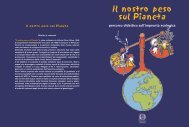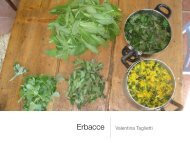Myanmar Protected Areas: Context, Current Status ... - Istituto Oikos
Myanmar Protected Areas: Context, Current Status ... - Istituto Oikos
Myanmar Protected Areas: Context, Current Status ... - Istituto Oikos
You also want an ePaper? Increase the reach of your titles
YUMPU automatically turns print PDFs into web optimized ePapers that Google loves.
Geography<br />
The Rakhine Yoma Elephant Range Wildlife Reserve (WR) is located in the southern portion of the<br />
Rakhine State, in the Thandwe District, inside the homonymous mountain range. The central area of<br />
the Yoma consists of a series of ridges running more or less from north to south, although the main<br />
drainage lines cut across them from east to west. The streams are in steep valleys with many waterfalls.<br />
The geology is dominated by Cretaceous Flysch-type sediments and limestones. The main lithologies<br />
found are sandstone, shales and limestone, where the soils are principally of the red brown forest type.<br />
The steep slopes and the friable soils result in frequent landslides. The area experiences a monsoonal<br />
climate typical of that found throughout Southern <strong>Myanmar</strong>. Rainfall occurs only between May and<br />
September, with an annual rainfall on the coast of more than 4000 mm (source: World Meteorological<br />
Organization and FAOCLIM database), decreasing towards the mainland to the east. The humidity is<br />
highly intercepted by the mountains, and in the valley of the Ayeyawaddy annual rainfall drops to<br />
around 1000 mm. Temperatures are usually between 20° C in January and less than 30° C during April/<br />
May. The leafless season for the deciduous species starts in December and ends at the beginning of the<br />
rainy season in May. The protected area was established in 2002 and is more than 1,700 Km². large. The<br />
main key protected resources are wildlife species, among the most important is a population of wild<br />
Asian Elephant (Elephas maximus): according to the Park staff, currently there are around 150 living in the<br />
area. The topography of the protected<br />
area is mountainous, ranging from<br />
80 meters asl. in the valleys of the<br />
southern region, to more than 1,200<br />
meters asl in the northern heights.<br />
Several streams and rivers dissect the<br />
area and are all part of the western<br />
catchment (e.g. Kyeintali river), flowing<br />
westwards to the sea which is located<br />
only around 15 km from the border<br />
of the PA. Moving towards the east<br />
side, outside the protected area, the<br />
elevation decreases as well, eventually<br />
reaching the large alluvial valley of the<br />
Ayeyawaddy river.The main vegetation<br />
types occurring inside the mountain<br />
range and in the protected area are<br />
the evergreen forest and the bamboo<br />
brakes. Going towards the sea there<br />
are many deciduous species mixing<br />
with the evergreen, and occasional<br />
mangrove forests or agricultural areas<br />
on the coast and in the narrow valleys.<br />
The pattern of vegetation types is<br />
determined by rainfall, altitude and<br />
exposure, therefore an interesting<br />
natural mosaic of different habitats was<br />
observed also in previous surveys (FAO<br />
1983a). On the east side dry deciduous<br />
species became quickly dominant,<br />
and eventually the agricultural areas<br />
prevail close the Ayeyawaddy River:<br />
the pattern of the vegetation seems to<br />
Location of Rakhine Yoma Elephant Range WR<br />
be more homogenous.<br />
In-depth Study of Rakhine Yoma Elephant Range Wildlife Reserve<br />
4.1 Data and methods<br />
The study was conducted following subsequent steps. In this context, a simple overview of the<br />
methodology used is given; for more information it is possible to contact the authors.<br />
Step 1. Data harmonisation and collection<br />
The first step was to carry out consultation meetings with Forestry experts from BANCA and<br />
Environmental experts from RCCA to review the baseline knowledge about the vegetation of the study<br />
area. At the same time, a GIS database was set up using, as a basis, topographic maps, Landsat satellite<br />
images and Digital Elevation Models, alongside many shapefiles coming from the <strong>Myanmar</strong> Information<br />
Management Unit (MIMU), the mapping facility of United Nations operating in Yangon. Combining all<br />
the information, a preliminary land cover classification of years 2000-2003 was carried out. The most<br />
evident land cover classes were drawn in a map, such as mangrove forests, bamboo brakes, evergreen<br />
forests, mixed deciduous forest and agricultural areas. With the same approach, a satellite image dating<br />
from 1974 was analyzed using as a primary source of information the knowledge of the past situation of<br />
the RCCA expert, eventually producing another draft vegetation map.<br />
Vegetation maps from international organizations, such as the JRC GLC2000 Project, UNEP 2001 Land Use/<br />
Land Cover, and ESA Ionia GlobCover, have been retrieved and their accuracy analysed. Unfortunately<br />
their spatial accuracy is very low compared to the needs of the present ²project, and some errors were<br />
found in such maps mainly due to the lack of a ground survey. For example, the UNEP 2001 land cover<br />
map erroneously classified some areas as covered by coniferous forest that are in fact absent in the study<br />
area. Therefore it has been chosen not to use them. Data used in this study are summarised in Table 1.<br />
Table 16 GIS data used<br />
LIST OF GIS DATA USED:<br />
Digital Elevation Models:<br />
Aster GDEM (a product of METI and NASA), 30 m of resolution<br />
Landsat Satellite Images (USGS – NASA):<br />
1) Landsat 7 ETM+, p133r048, Date: 03.03.2000<br />
2) Landsat 7 ETM+, p133r047, Date: 24.02.2000<br />
3) Landsat 7 ETM+, p134r047, Date: 03.03.2003<br />
4) Landsat 1 TM, p143r048, Date: 11.02.1974<br />
Topographic Maps:<br />
Indian Grid IVB, Sheets 85J-85K-85L, Half-Inch to One Mile<br />
Climate:<br />
FAOCLIM database<br />
Shapefiles:<br />
Administrative boundaries, Road network, Hydrology<br />
(all from <strong>Myanmar</strong> Information Management Unit)<br />
Step 2. Ground truth campaign<br />
Subsequently, a field trip of five days (from 22nd to 26th March 2010) was organized to collect ground<br />
truth data, in order to refine the preliminary classification and define a complete legend of the vegetation<br />
types occurring in the area. The map below indicates the route followed by the field team, comprising: a<br />
remote Sensing researcher from the University of Milano - Bicocca, a GIS expert from the <strong>Istituto</strong> <strong>Oikos</strong>,<br />
a forestry expert from BANCA, an environmental expert from RCCA.<br />
134 135






